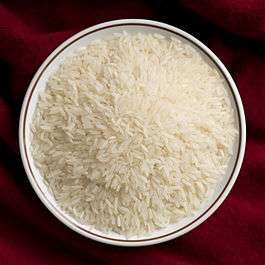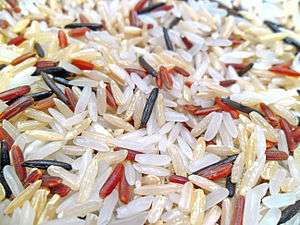Jasmine rice

Jasmine rice (Thai: ข้าวหอมมะลิ; rtgs: Khao hom mali; Thai pronunciation: [kʰâːw hɔ̌ːm malíʔ]; Chinese: 泰国香米; Tàiguó xiāngmǐ) is a long-grain variety of fragrant rice (also known as aromatic rice). Its fragrance, reminiscent of pandan (Pandanus amaryllifolius) and popcorn,[1] results from the rice plant's natural production of aromatic compounds, of which 2-acetyl-1-pyrroline is the most salient.[2] In typical packaging and storage, these aromatic compounds dissipate within a few months.[3][4] This rapid loss of aromatic intensity leads many Southeast Asians and connoisseurs to prefer each year's freshly harvested "new crop" of jasmine rice.[5]
Jasmine rice is a variety of Oryza indica.[6] The name "jasmine" refers to the color of the rice, which is as white as the jasmine flower.[7]
Jasmine rice is grown primarily in Thailand (Thai hom mali or Thai fragrant rice), Cambodia (angkor kra'oup or Cambodian jasmine rice), Laos, and southern Vietnam. It is moist and soft in texture when cooked, with a slightly sweet flavor. The grains cling and are somewhat sticky when cooked, though less sticky than glutinous rice (Oryza sativa var. glutinosa), as it has less amylopectin. It is about three times stickier than American long-grain rice.
To harvest jasmine rice, the long stalks are cut and threshed. The rice can then be left in a hulled form called paddy rice, de-hulled to produce brown rice, or milled to remove the germ and some or all of the bran, producing white rice.
Types
Thai jasmine rice and Cambodian rice share many of the same characteristics and grow mainly in neighboring geographic areas on opposite sides of the northeastern Thai-Cambodian border. Cambodian jasmine rice is cultivated in Cambodia and processed as white (milled and polished) and brown rice. Distinct Cambodian jasmine rice varieties include these three, phka rumduol, phka romeat, and phka rumdeng. Recent DNA fingerprint analysis, carried out with 18 markers, shows that all three varieties possess 18 known fragrance alleles. Two varietals (phka rumduol and phka rumdeng) are distinctly Cambodian with 17 markers in identical positions, with Thai jasmine rice and one fragrance marker each in a different position. The analysis of Cambodian phka romeat shows all 18 markers in identical positions with the trademarked Thai jasmine rice Thai hom mali.[8]
Jasmine rice, though grown in Laos and southern Vietnam, is not the predominant rice variety. Glutinous rice is grown in Laos, and regular Oryza sativa predominates in Vietnam.
Thai jasmine rice from Thailand has a slender shape and a jasmine scent.[9]:12-13 The two types of Thai jasmine rice are white and brown.[10] The vast majority of jasmine rice exported overseas to North America and Europe is Thai jasmine rice, with a small minority from Vietnam. In Thailand it is thought that only Surin, Buriram, and Sisaket Provinces can produce high quality hom mali.[11]
White jasmine rice

White jasmine rice is white, has a jasmine aroma and, when cooked, a slightly sticky texture.[9]:8-13 The aroma is caused by the evaporation of 2-Acetyl-1-pyrroline.[9]:8-13
Brown jasmine rice
Brown jasmine rice retains the light tan outer layer on the rice grain.[12] It has greater health benefits than white jasmine rice because it still has the bran.[13] Brown jasmine rice has a flavor like oats and contains gamma oryzanol which can decrease cholesterol in blood vessels.[14] Brown jasmine rice has vitamins such as vitamin A, vitamin B, and beta-carotene[15] and it contains antioxidants which support the working of nervous system.[12]
Glycemic index
Jasmine rice has a glycemic index of 68-80.[16] Foods with a glycemic index of 70 or lower are preferred in the diet due to their slower absorption which prevents large spikes in blood sugar after consumption. Not all rice has a high glycemic index. Basmati rice, for example, has a relatively low glycemic index of 59. However, it is uncommon for rice to be eaten alone. It is usually eaten with other foods that can reduce its glycemic index by 20-40 percent.[17]
Culinary uses
Steamed jasmine rice is ideal for eating with stir fries, with grilled, fried, or braised food items, and in soups (when cooked slightly drier by adding a little less water during cooking). It often doesn't fare well when used for fried rice, as it is too soft and soggy when still warm. More experienced cooks will use rice that has been cooled down first for making fried rice.[18]
See also
References
- ↑ Uraiwan Tanchotikul,. "An improved method for quantification of 2-acetyl-1-pyrroline, a "popcorn"-like aroma, in aromatic rice by high-resolution gas chromatography/mass spectrometry/selected ion monitoring". J. Agric. Food Chem. 39 (5): 944–947. doi:10.1021/jf00005a029.
- ↑ S. Wongpornchai. "Identification and quantitation of the rice aroma compound, 2-acetyl-1-pyrroline, in bread flowers (Vallaris glabra Ktze)". J. Agric. Food. Chem. 51 (2): 457–462. doi:10.1021/jf025856x. PMID 12517110.
- ↑ Plamondon, James (October 29, 2015). "The Science of Jasmine Rice". AwardBest. Retrieved February 2, 2016.
- ↑ "What is Jasmine Rice?". wiseGEEK. Conjecture Corporation.
- ↑ Gershenson, Lisa (Winter 2015). "New Crop Rice". Cook's Gazette. Retrieved February 2, 2016.
- ↑ http://www.majordifferences.com/2013/11/difference-between-japonica-and-indica.html
- ↑ Plamondon, James (January 29, 2016). "Why is "jasmine rice" called "jasmine"?". AwardBest. Retrieved February 2, 2016.
- ↑ http://www.cardi.org.kh/index.php?page=detail&ctype=article&id=212&lg=en[]
- 1 2 3 K. Khunket; A. Wutthanet; A. Prasertsak; S. Traprap. ข้าวขาวดอกมะลิ 105. กรมการข้าว สำนักวิจัยและพัฒนาข้าว.
- ↑ W. Leanjumroon, N. Yuwanaboon. หอมกลิ่นข้าวมะลิหอม. BIOTHAI. p. 10.
- ↑ Yongcharoenchai, Chaiyot (6 November 2016). "The Rice Man Cometh". Bangkok Post. Retrieved 10 November 2016.
- 1 2 "The benefits of Thai jasmine rice". welovelb. Retrieved October 20, 2013.
- ↑ "Benefits of Brown jasmine rice". Manob Keawsanid. Retrieved October 20, 2013.
- ↑ "Jasmine Rice Health Benefits, Nutrition Facts". diethealthclub. Retrieved October 20, 2013.
- ↑ "The benefits of jasmine rice". Sinsomboon Rice Mill. Retrieved October 27, 2013.
- ↑ Venn, Bernard J; Kataoka, Minako; Mann, Jim (2014). "The use of different reference foods in determining the glycemic index of starchy and non-starchy test foods". Nutrition Journal. 13: 50. doi:10.1186/1475-2891-13-50. PMC 4047427
 . PMID 24885045.
. PMID 24885045. - ↑ Sugiyama, M; Tang, A C; Wakaki, Y; Koyama, W (2003). "Glycemic index of single and mixed meal foods among common Japanese foods with white rice as a reference food". European Journal of Clinical Nutrition. 57 (6): 743–52. doi:10.1038/sj.ejcn.1601606. PMID 12792658.
- ↑ http://www.thekitchn.com/why-dayold-rice-makes-the-best-fried-rice-tips-from-the-kitchn-208326[]
